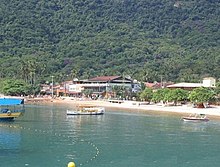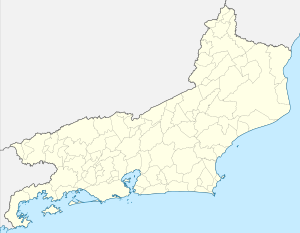Ilha Grande
| Ilha Grande | ||
|---|---|---|
| Topographic map | ||
| Waters | Atlantic Ocean | |
| Geographical location | 23 ° 8 ′ S , 44 ° 15 ′ W | |
|
|
||
| length | 29 km | |
| width | 11.8 km | |
| surface | 193 km² | |
| Highest elevation | Pico da Pedra D'Água 1031 m |
|
| Residents | 3000 16 inhabitants / km² |
|
| main place | Vila do Abraão | |
The Ilha Grande (Portuguese Big Island ) is one of the most famous islands in Brazil with its 86 beaches . It belongs to the city of Angra dos Reis in the west of the state of Rio de Janeiro and is located about 160 km west of the city of Rio de Janeiro between the Baía de Sepetiba and the Baía da Ilha Grande in the Atlantic .
There are ferry connections from the main town of Vila do Abraão to Angra dos Reis city center and to Mangaratiba on the mainland. The journey time is approx. 75 minutes to the island, which is approx. 25 km away.
The Ilha Grande National Park is a part (5,594 ha) of the entire island (193 km²), which is located off the south coast of the state of Rio de Janeiro between the seaside resorts of Mangaratiba and Angra dos Reis. About half of the park (47%) is covered with dense Atlantic rainforest ( Mata Atlântica ). On the Ilha Grande there are numerous representatives of rare animals, such as B. Howler monkeys , parrots, turtles, snakes and the relatively little researched Guyana dolphin . From the mountain Pico do Papagaio ("Parrot's peak ", 982 m) one has a view over the whole island and with good visibility over to the mainland to Mangaratiba.
The Ilha Grande is part of the Tamoios - nature reserve and is divided into the actual State Park, Marine -Staatspark and the Biological Reserve Praia do Sul . In addition, the waters and beaches of the Ilha Grande are now popular excursion and holiday destinations. There are a large number of pousadas (guest houses), some of which can only be reached by boat and are often very luxuriously furnished.
In 2019 the island, together with the old town of Paraty as Paraty and Ilha Grande - Culture and Biodiversity , was declared a World Heritage Site by UNESCO .

history
In the middle of the 16th century, the mercenary Hans Staden wrote the first travelogue in which the island is mentioned. In the service of the Portuguese royal family, he was in command of a small fortress north of São Vicente. In early 1554 he was captured by Indians. On a campaign with the Tupinamba he stopped on the island.
After more than nine months of captivity, he was freed by a French captain in 1555. He came back to Wolfhagen (Hesse) and published his chronicle in Marburg in 1557 "Warhaftige history and description of a landscape of wild, naked, grim ogre-eaters". The record of Stadens is the first description of Indian customs in Brazil.
Large freshwater reserves, tropical fruits, large deposits of Brazilian wood , a precious wood, but above all the proximity to the port city of Paraty , from where the Brazilian gold was shipped to Europe, made the Ilha Grande a preferred refuge for European pirates and corsairs after visiting cities . About 50 shipwrecks between Angra do Reis and the Ilha Grande are witnesses of the battles that occurred in the 16th and 17th centuries between pirates, Tamoios Indians and Portuguese.
Thereafter, in the 18th century, Ilha Grande became one of the main trading centers for the slave trade . In one of the darkest chapters of Brazilian history, ships with men, children and women from Africa landed on the beaches of Palmas and Dois Rios for over 200 years , destined for the heavy work on the sugar cane plantations and fazendas (farms) of Rio de Janeiro.
In 1888, after the abolition of slavery , Brazil opened its doors to immigrants - mainly European and Asian - in order to be able to meet the growing need for workers. Since some of these countries were affected by cholera epidemics at the time , Dom Pedro II had a quarantine hospital built on Ilha Grande, in which immigrants had to stay for a while before they were officially allowed to enter Brazil. The ruins of the hospital are now overgrown by tropical rainforest, but they are still there.
Later the island was declared a closed colony for lepers (Hanseníase or Hansen disease) and the Colônia Penal Cândido Mendes prison was built, where first dangerous criminals landed, then mainly political prisoners during the Estado Novo and later during the military rule from 1964 . The place was chosen because an escape from the island was considered hopeless at the time, as the mainland was about 25 km away. Today there is a museum in the building ( Museu do Cárcere ).
In 1993 the government of the state of Rio de Janeiro decided to close the prison. Thereafter, the Universidade do Estado do Rio de Janeiro received the right to set up a center for environmental studies (Centro de Estudos Ambientais e Desenvolvimento Sustentável (CEADS)), which was inaugurated in 1998.
On January 1, 2010, a disastrous landslide occurred at Praia do Bananal. Several buildings of the Pousada Sankay located there were destroyed and 26 people lost their lives.
Illustrations
Main beaches
Clockwise from Vila do Abraão:

- Abraão
- Palmas
- Pouso
- Dois Rios
- Parnaioca
- Sul
- Leste
- Aventureiro
- Provetá
- Praia Vermelha
- Araçatiba
- Longa
- Ubatubinha
- Bananal
- Freguesia de Santana
- Japariz
- Enseada das Estrelas
- Feiticeira
- Preta
Web links
- Ilha Grande - Brasil Turismo. In: brasilturismo.com. web.archive.org, 2012, archived from the original on May 20, 2012 .
- Description, pictures, maps (Portuguese)
- Angra dos Reis and Ilha Grande - pictures and brief information (German)
- Angra dos Reis Local Info (Portuguese)
Individual evidence
- ^ Pico do Papagaio. (No longer available online.) Archived from the original on August 16, 2011 ; Retrieved April 23, 2011 . Info: The archive link was inserted automatically and has not yet been checked. Please check the original and archive link according to the instructions and then remove this notice.
- ^ Paraty and Ilha Grande - Culture and Biodiversity. UNESCO World Heritage Center, accessed July 9, 2019 .
- ↑ Museu do Carcere. In: ilhagrande.org. Ilha Grande - RJ, accessed June 24, 2020 .
- ^ "Deaths from Brazil Ilha Grande resort mudslide reach 26" . BBC NEWS. January 2, 2010 (English).










